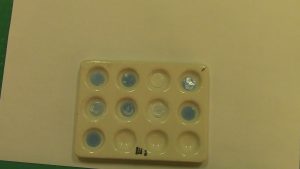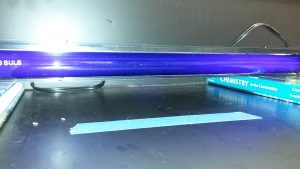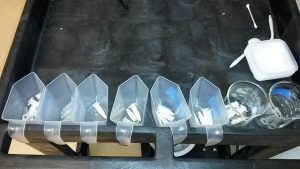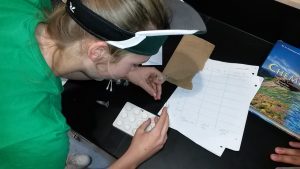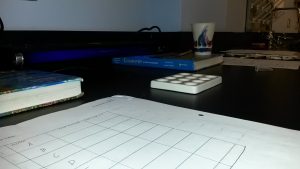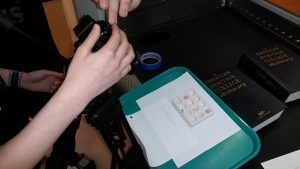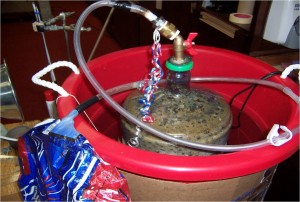This is the last of a series of three posts that address a controlled experiment, which investigated the UV blocking potential of a variety of lotions. See my earlier posts dated May 17th, 2016 and December 20th, 2015 for additional information. The 12/20 post focused on project goals/objectives, resources, a description of the activity, and assessment standards. The 5/17 post dealt more with how the activity was implemented in the classroom. In this post, I will share my conclusions from the results of four student work samples from honors chemistry (Student work sample #1; Student work sample #2; Student work sample 3; Student work sample #4), as well a compilation of research team data from my two general chemistry classes (UV Blocking Class Data Table). The identities of the 8 lotions (A-H) are listed at the bottom of this table.
The student work samples are wholly the product of the student’s themselves. As an end of year summative assessment of student’s ability to execute and report on a controlled experiment, I provided no written comments from which students could make revisions in preparation for their final draft. I did, however, answer specific questions individuals may have asked of me at any point during the project. I also provided a set of project guidelines (see May 17th for details). Student research teams were provided with the problem, and a set of verbal instructions for how to perform the experiment. However, I did not explicitly identify the experimental, depended, and relevant control variables. As such, I would classify this activity as a guided inquiry, although I made an effort to keep the guidance to a minimum.
All students qualitatively analyzed their results by ranking UV blocking potential based on visual observation. As an extension, my honors chemistry students also used Analyzing Digital Imaging (ADI) software in an effort to quantify their experimental results by analyzing digital photographs. Curious to see what students would come up with on their own, I provided no instruction in how to use the ADI software to quantifiy UV blocking potential of the lotion coated beads.
Below is a bullet point list of my general observations from this project.
- Student’s demonstrated a sound understanding of how to write a technical report. Report sections were clearly labled, with the relevent information included.
- Nearly all student’s successfully identified the expereimental, dependent, and relevant control variables.
- Student’s generally did a good job of identifying sources of error and making recommendations for how these errors could be minimized if the experiment were repeated.
- While many research teams opted to perform multiple trials of their experiment, very few understood the importance of summarizing the results of multiple trails by calculating an average. This came as a surprise to me, as we have calculated average values in numerous other experiments performed earlier in the year. As a post experiment exercise intended to demonstrate how averages can help inform our decision making, we compiled data across all research teams. The average results did indeed prove more accurate than the conclusions of any one research team (see UV Blocking Class Data Table1 above).
- Through their own background research, I had presumed that most students would identify the possible link between ozone layer depletion, increased UV exposure, and increased rates of skin cancer. Although a few students did make this connection (see Student Work Sample #2), most did not.
- Students are prone to making claims based on conjecture, unsubstantiated by even secondary sources of information, when performing background research.
- The results from analysis using ADI software were problematic due to the presence of glare in student photgraphs. Of greater concern, however, was that while most teams were able to develop a method for using ADI to interpret their data, very few student’s reported on these results successfully. They posted well organized tables of ADI data in the results section of their report, but neglected to describe (in the procedure) how the analysis was performed, and also failed to to explain the meaning of their data (in the discussion). One noteable exception is here.
- Students did a good job of listing their background references using MLA format on a citations page. However, it was impossible to link these sources to the specific content of a student’s background statement. This is entirely an error made by me, as I neglected to teach my student’s how to use the (Author, date) scientific style of referencing citations. I will surely address this shortcoming in the future.
- As a broad final conclusion, my honors level students are quite adept at following directions and demonstrating aquired skills when prompted. But they are less succssful at then applying their new knowledge and skills independently in novel prolem solving situations. To address this shortcoming, I feel students need more opportunities to work on open ended problems and have the freedom to make mistakes. Rather than correcting mistakes as they happen (or before they happen), we as teachers should provide more opportunities to allow mistakes to happen, and address them later.

